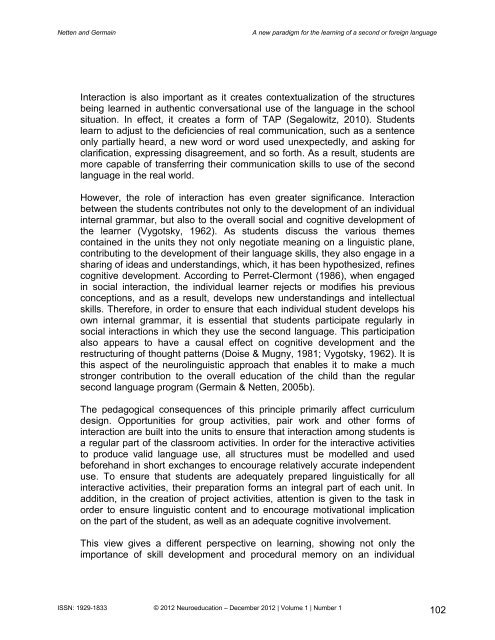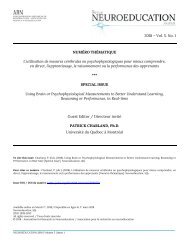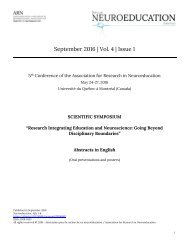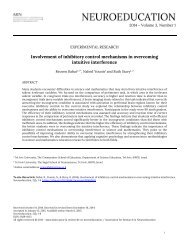Neuroeducation_2012_vol-1_no-1_full
Neuroeducation journal - Volume 1, Issue 1 (2012) - 144 pages
Neuroeducation journal - Volume 1, Issue 1 (2012) - 144 pages
Create successful ePaper yourself
Turn your PDF publications into a flip-book with our unique Google optimized e-Paper software.
Netten and Germain<br />
A new paradigm for the learning of a second or foreign language<br />
Interaction is also important as it creates contextualization of the structures<br />
being learned in authentic conversational use of the language in the school<br />
situation. In effect, it creates a form of TAP (Segalowitz, 2010). Students<br />
learn to adjust to the deficiencies of real communication, such as a sentence<br />
only partially heard, a new word or word used unexpectedly, and asking for<br />
clarification, expressing disagreement, and so forth. As a result, students are<br />
more capable of transferring their communication skills to use of the second<br />
language in the real world.<br />
However, the role of interaction has even greater significance. Interaction<br />
between the students contributes <strong>no</strong>t only to the development of an individual<br />
internal grammar, but also to the overall social and cognitive development of<br />
the learner (Vygotsky, 1962). As students discuss the various themes<br />
contained in the units they <strong>no</strong>t only negotiate meaning on a linguistic plane,<br />
contributing to the development of their language skills, they also engage in a<br />
sharing of ideas and understandings, which, it has been hypothesized, refines<br />
cognitive development. According to Perret-Clermont (1986), when engaged<br />
in social interaction, the individual learner rejects or modifies his previous<br />
conceptions, and as a result, develops new understandings and intellectual<br />
skills. Therefore, in order to ensure that each individual student develops his<br />
own internal grammar, it is essential that students participate regularly in<br />
social interactions in which they use the second language. This participation<br />
also appears to have a causal effect on cognitive development and the<br />
restructuring of thought patterns (Doise & Mugny, 1981; Vygotsky, 1962). It is<br />
this aspect of the neurolinguistic approach that enables it to make a much<br />
stronger contribution to the overall education of the child than the regular<br />
second language program (Germain & Netten, 2005b).<br />
The pedagogical consequences of this principle primarily affect curriculum<br />
design. Opportunities for group activities, pair work and other forms of<br />
interaction are built into the units to ensure that interaction among students is<br />
a regular part of the classroom activities. In order for the interactive activities<br />
to produce valid language use, all structures must be modelled and used<br />
beforehand in short exchanges to encourage relatively accurate independent<br />
use. To ensure that students are adequately prepared linguistically for all<br />
interactive activities, their preparation forms an integral part of each unit. In<br />
addition, in the creation of project activities, attention is given to the task in<br />
order to ensure linguistic content and to encourage motivational implication<br />
on the part of the student, as well as an adequate cognitive in<strong>vol</strong>vement.<br />
This view gives a different perspective on learning, showing <strong>no</strong>t only the<br />
importance of skill development and procedural memory on an individual<br />
ISSN: 1929-1833 © <strong>2012</strong> <strong>Neuroeducation</strong> – December <strong>2012</strong> | Volume 1 | Number 1<br />
102








